Investigating the Galaxy Nexus LTE Signal Issue
by Brian Klug on December 19, 2011 8:24 PM EST- Posted in
- Smartphones
- Verizon
- LTE
- Droid Charge
- Mobile
- galaxy nexus
- Android 4.0
It seems that each time an LTE handset comes out, there’s invariably some perceived issue with connectivity and stability. This time, focus is being placed on Verizon’s CDMA/LTE variant of the Galaxy Nexus, and the issue surrounds LTE connectivity robustness compared to the other LTE handsets out there.
I’ve been running battery life tests on our LTE Galaxy Nexus review unit since release day (a process that takes a considerable amount of time and results in our reviews posting a while behind everyone else’s), but have had some time to run tests and gauge subjective performance. I found that LTE connectivity and performance felt above average, subjectively, and noted that in a tweet. After complaints started to surface, I spent a considerable amount of time reading the threads on XDA and other places around the web trying to discern what the complaints are about. I’ve seen a couple of big misconceptions that I think really get to the heart of the matter.
First off, is some background. The Verizon CDMA/LTE Galaxy Nexus (codename “mysid”) uses a combination of Samsung CMC221 and Via Telecom CBP 7.1 for LTE and CDMA 1x/EVDO connectivity, respectively. This is virtually identical (unsurprisingly) to the Droid Charge, which used a CMC220 for LTE and the same CBP 7.1. The CMC22x family is UE Category 3, which currently is the highest for shipping devices and means it can handle up to 100 Mbps downstream with 20 MHz FDD. To date, all of the LTE basebands in Verizon LTE devices have been UE category 3 with the exception of Motorola’s devices, which are all UE category 2, but I digress. We’ve reached out to Samsung Semiconductor about what’s changed between CMC220 and 221, but doubtless the changes improve connection stability and reliability.
Speeds thus far have also been excellent. I’ve squeezed in 183 speedtests between battery life testing, and have seen some of the fastest LTE connectivity out of the Galaxy Nexus to date. After testing so many Motorola LTE devices with UE Category 2 modems, it’s refreshing to see this kind of performance out of a UE Category 3 device.
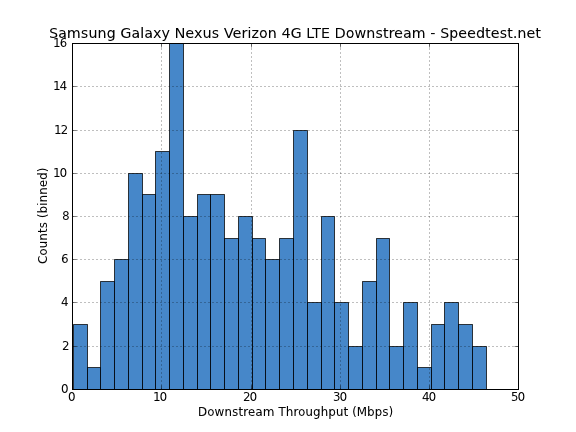
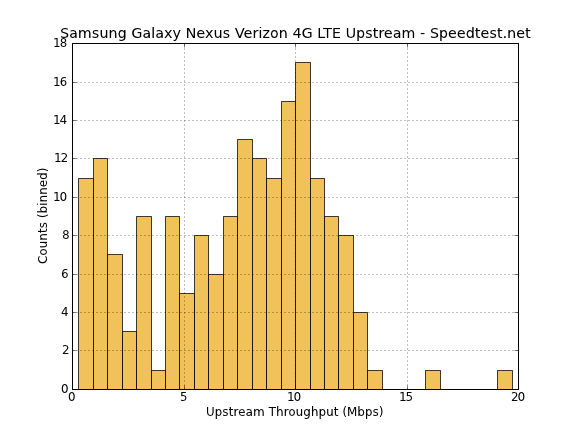
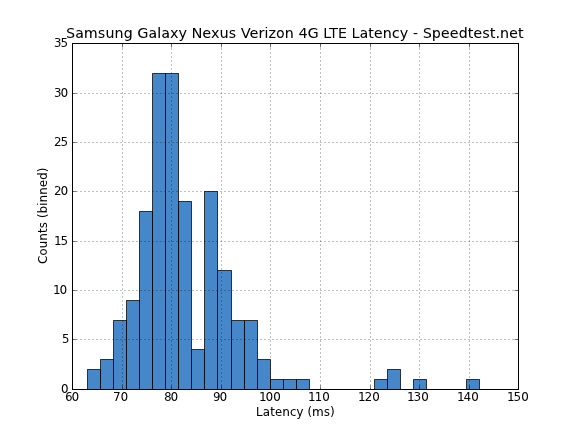
The issue that most people talk about centers around signal strength, and this is where a few misconceptions kick in. I’ve gotten a few emails and tweets and read pages on forums where people are implicitly comparing CDMA2000 1x/EVDO field strength to LTE field strength. The issue here is that on basically all of the LTE/CDMA Verizon handsets, the field under “Signal Strength” in about refers to EVDO signal strength, and not LTE signal strength. The two aren’t comparable at all for a host of reasons - different spectrum (800 MHz and 1900 MHz for 1x/EVDO as opposed to 700 MHz for LTE), and different cells (there’s some correlation, but not every Verizon base station has LTE onboard). The end result is that if you’re comparing 1x/EVDO signal strength to LTE signal strength, you’re making an absolutely meaningless apples to oranges comparison.
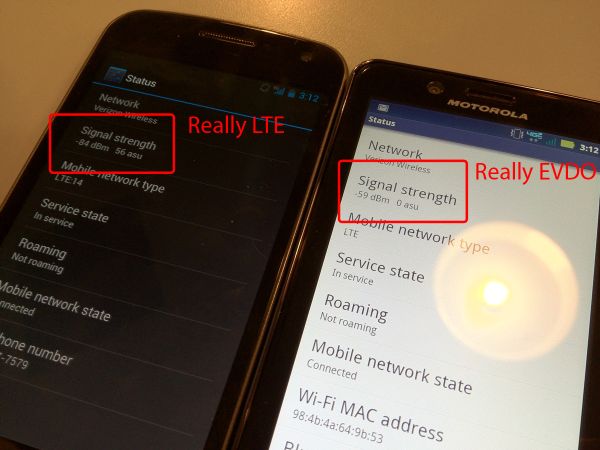
This is not a valid comparison - LTE versus EVDO signal strength
The Galaxy Nexus (and really just Android 4.0) now correctly reports and accommodates LTE by reporting its signal strength under “About->Status” and visualizing that as bars appropriately. Switch to EVDO on the Galaxy Nexus and signal strength appropriately changes to reflect an entirely different air interface’s signal strength. It’s nice to see people using dBm instead of bars when possible (which are effectively meaningless as a comparison metric), but now that there are multiple air interfaces on handsets, we have to be explicit about what numbers we’re actually comparing.
This reporting is a problem I’ve talked about at length in more than one LTE handset review, and to date I only know of ways to show LTE signal strength and channel quality on a few handsets. Samsung’s Droid Charge (courtesy Samsung’s excellent ServiceMode application viewed through *#0011# after some unlock trickery) and the Bionic (through logcat and grepping for the radio signal status daemon) report LTE field strength, but only if you dig for them.
Comparing LTE Signal Strength the Right Way
So how does the LTE Galaxy Nexus compare to the Droid Charge and Bionic, the two handsets we can actually view LTE signal strength in dBm on? Very closely as a matter of fact.
I have a Bionic kicking around which has to go back very soon, but fired up logcat and put the Galaxy Nexus next to it. The Bionic reports signal strength pretty constantly whereas in Android 4.0 the number has some hysteresis, but here the numbers are pretty darn close, with the Bionic hovering between -91 and -95 dBm, and the Galaxy Nexus reporting an average of -92 dBm.
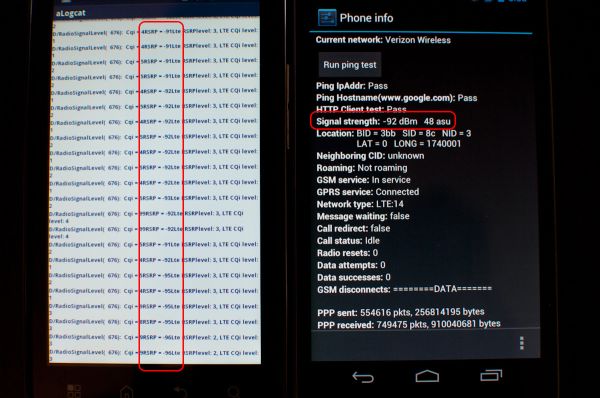
Left: Motorola Droid Bionic (logcat showing LTE signal strength), Right: Galaxy Nexus
Since the Droid Charge is the only other handset I know how to show LTE signal strength on, I tracked a friend down at a local cafe with one and fired up service mode. Again, what’s shown under “About->Status” on the Droid Charge is actually EVDO signal strength. Here the Galaxy Nexus shows -107 dBm and the Droid Charge shows -108 dBm.
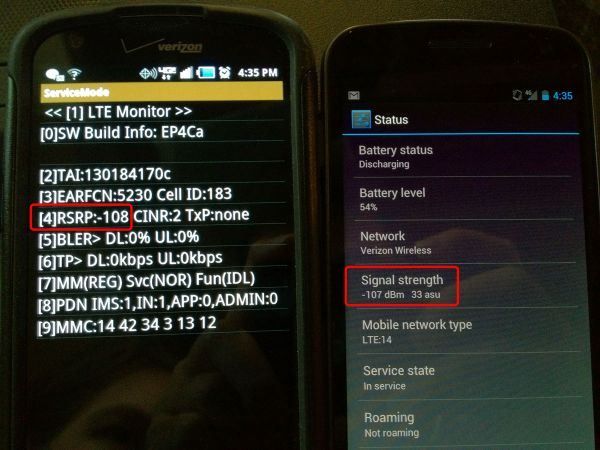
Left: Samsung Droid Charge (ServiceMode) Right: Galaxy Nexus
The Droid Charge is another hilarious example of why you can’t compare bars at all, as the Charge shows a positively laughable 4 out of 5 bars in an area with very low LTE signal strength, whereas the Galaxy Nexus (moreover, Android 4.0) has a very conservative and realistic strength to bars mapping. Carriers love to make things out to be better than they really are, however, and the result is this kind of hilarious visualization which portrays LTE signal as being much better than it really is if you stare at bars all day.
Verizon confirming though a tweet that there’s some sort of signal issue affecting the Galaxy Nexus confuses me, since from my perspective there isn’t any issue at all. The only real issue that exists is that the Galaxy Nexus (and really just the stock Android 4.0 signal strength to bars mapping) doesn’t line up with what Verizon has shipped on other devices, thus leading people to make apples to oranges comparisons and imagine an issue. I wager that some of this confusion is also compounded from the number of Verizon customers that are just now getting their first LTE handset with the Galaxy Nexus. It might be surprising to discover that LTE coverage right now isn't nearly as good as 1x/EVDO, but these things will improve as the carrier's LTE rollout continues. The other big disclamer is that I haven't fully investigated 1x/EVDO performance on the Galaxy Nexus, but this will end up being virtually identical to the Droid Charge.
There’s a CDMA and LTE baseband update coming with the LTE Galaxy Nexus’ 4.0.3 update as shown above, but this will likely do more to address connection stability than change the way anything is reported. Given how much attention this has gotten, however, I would not be surprised to see Google make a change to its signal strength to bars mapping for LTE and placebo away an issue that never really existed to begin with. That's also an unfortunate change, since from my perspective the Galaxy Nexus is one of the first handets that doesn't have an unrealistic mapping. In the meantime, we're still working on our Galaxy Nexus review where we'll take a complete look at the LTE/CDMA and GSM/UMTS Galaxy Nexii.
Update:
As predicted, Verizon has made a statement to The Verge and Computerworld stating that there's nothing wrong with the RF performance characteristics or baseband firmware on the LTE/CDMA Galaxy Nexus. Instead, they will upstream some changes to Android to make the device report its bars visualization in line with the rest of its 4G LTE hardware portfolio.
"[Verizon] will adjust the signal strength indicator to more closely match other Verizon Wireless devices.


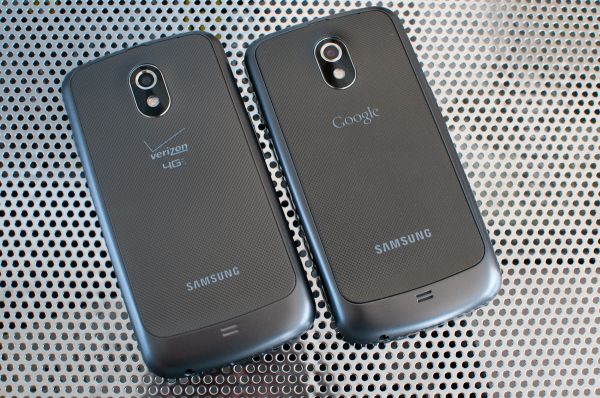









154 Comments
View All Comments
raen_rfm - Monday, February 6, 2012 - link
I think all these comments are a bit misguided. Using a cellphone to gauge signal strength is indeed comparing apples to oranges, and not very good apples and oranges. The only way to settle the issue is to use a CALIBRATED field strength meter and compare with each phone and even then all the phone can tell you is the signal it's receiving based on it's orientation, whether or not you're holding it with your hand or a myriad of other possible combinations.Your carrier can only provide one signal for every possible handset that they support and trying to tweak that signal is a very fussy task (I work for a telco). Just the nature of wireless technology makes it impossible to please every single subscriber all the time and everywhere. Things like traffic on a given cell can shrink the coverage and that is another issue that has to be dealt with. I'm not defending any telco's but I do have an insight into the challenges involved in delivering coverage that satisfies the maximum number of subs at any given time.
mrmichaelhallett - Sunday, February 19, 2012 - link
HelloThere are 2 hardware versions of the Galaxy Nexus which one do you have?
It seems that the people with radio version 9 are having most of the problems.
Mine was so bad I got it replaced. ... unfortunately they sent me a refurb v 9.
(1515.09 instead of the coveted 1515.10 radio)
Can't get a straight answer about whether this is hardware (seems to be) or firmware.
Tried different roms , different radios, going back to stock radio software .
Now on a version code named EK02 and still having Could Not Connect errors. etc.
At times going into market to install anything takes forever (one app only installed after an hour of waiting once I woke the screen back up.
Sometime voice command will errror out with Could not Connect.
often get message could not be sent texting.
BTW I am in the middle of the second most populous city in Maine (04240)
Toggling in and out of airplane mode sometimes allows phone to connect.
also note that call quality is very good and I dont really have dropped calls.
I think that there is more going on than just peoples perceptions. I am hoping that an update (4.03? 4.04? will help ... otherwise I'll be pushing for a second replacement and hoping for a v 10 radio)
Just my .02 worth.
Michael
happyhappy - Saturday, February 25, 2012 - link
He's right. Its cheap and plasticky feeling like pretty much every other Samsung phone. Deal with it.( http://www.laptopbatterymag.com/asus-g73jh-a2.htm )
ASUS G73JH-A2 battery
( http://www.laptopbatterymag.com/asus-g73jh-asus-g7... )
ASUS G73JH battery,ASUS G73JH-A1 battery
ghd nz - Monday, January 7, 2013 - link
http://www.chihair-straightener.us